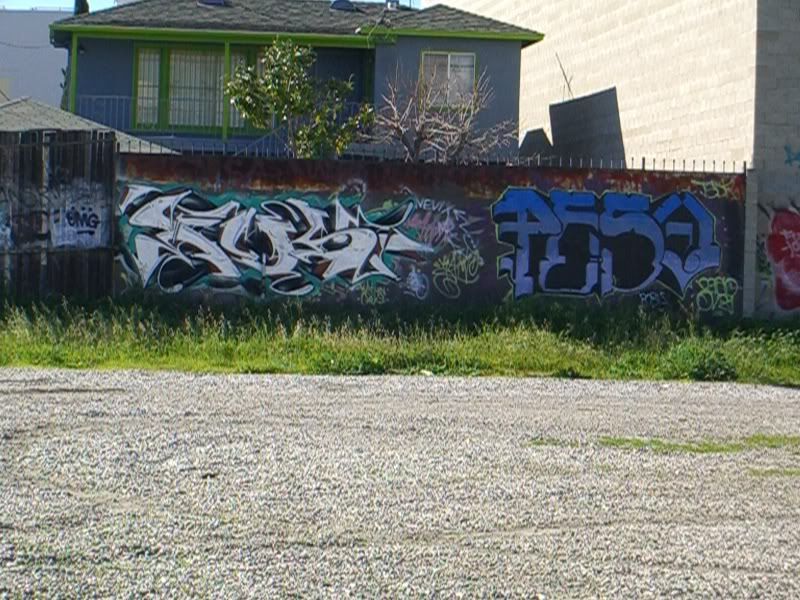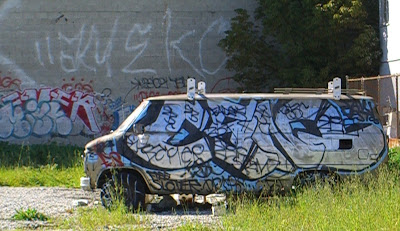
Thursday, January 31, 2008
Layla. Got me on my knees girl!
Friends dog. Six years old, she was recovered from the pound, nursed through pneumonia and is now one of my favorite walking buddies!


Tuesday, January 29, 2008
Graffiti in LA: Some views in K-town
Thursday, January 24, 2008
Wednesday, January 23, 2008
Watts Towers in Los Angeles: Revolutionary Vision
So my Nana and my Nina have this story of how, as young adults, they would wake up to the sounds of a hammer hitting metal. Imagine that one day a neighbor down the street starts hammering away on some personal project of his. The hammering goes on for years, all the day long, day in and day out. Clanging metal becomes part of the regular sounds of the neighborhood along with farm animals, kids playing in the street, and the occasional car horn. Preferring to work alone, the guy seems a bit "out there", but friendly, 'cause he collects a number of items from the local community and integrates them into his little pet project, which he liked to call, "Nuestro Pueblo" ("Our Town"). My Nana and Nina were two of the townspeople that exchanged bottles, plates, and other items with the man, sometimes for a penny or more. They'd use this extra income to go to the "show." And while the shows are long gone, and the community has changed, this guys art--and items my family gave him--remain part of his project to this day.
So yea, one day the hammering came to a halt. And there in this residential neighborhood of the 1950's stood 17 interconnected structures, two of which are taller than seven stories. That is the story of how the Watts Towers in Los Angeles, California, affected people like my Grandma and my Godmother, the people of "Nuestro Pueblo".

Simon Rodia built the Watts Towers between 1921 and 1954, and--withstanding the pressures of change and time--they have stood there ever since. The structures were made with such materials as steel pipes and rods, wire mesh, mortar, porcelain, tile, and glass. The structures are decorated with items that children and the local community brought to Rodia and also with items he found in the neighborhood and surrounding areas such as bed frames, recognizable soft-drink bottles (some bearing the logos of 7up, Squirt, and Canada Dry), ceramic tiles, scrap metal and sea shells.

The story goes that Rodia built the towers with no predetermined design and only used hand tools like hammers and window-washers' equipment. The towers are on the National Register of Historic Places, and are designated as a National Historic Landmark. Not only are some of my family's dishes part of this nationally recognized historic structure, but--more importantly to me--this structure, the time period it was created, and the community of the time is just another piece of LA that makes up part of my family's history.

So yea, one day the hammering came to a halt. And there in this residential neighborhood of the 1950's stood 17 interconnected structures, two of which are taller than seven stories. That is the story of how the Watts Towers in Los Angeles, California, affected people like my Grandma and my Godmother, the people of "Nuestro Pueblo".

Simon Rodia built the Watts Towers between 1921 and 1954, and--withstanding the pressures of change and time--they have stood there ever since. The structures were made with such materials as steel pipes and rods, wire mesh, mortar, porcelain, tile, and glass. The structures are decorated with items that children and the local community brought to Rodia and also with items he found in the neighborhood and surrounding areas such as bed frames, recognizable soft-drink bottles (some bearing the logos of 7up, Squirt, and Canada Dry), ceramic tiles, scrap metal and sea shells.

The story goes that Rodia built the towers with no predetermined design and only used hand tools like hammers and window-washers' equipment. The towers are on the National Register of Historic Places, and are designated as a National Historic Landmark. Not only are some of my family's dishes part of this nationally recognized historic structure, but--more importantly to me--this structure, the time period it was created, and the community of the time is just another piece of LA that makes up part of my family's history.
Sunday, January 20, 2008
Family visits: Flies, Sighs, and Eva Mendez' Eyes
 It's always great when family is over and we talk about all the funny things we've done over the years, especially as kids. Growing up I had an uncanny resemblance to the character, Piggy, from the movie, Lord of the Flies (circa 1990). We saw it on its release date when I was ten years old. Let's just say that I looked so much like Piggy that people were pointing, gawking, and whispering to one another--"that's him"--as I left the theater. Thinking it was funny, I popped the collar on my brown leather jacket and played the role of a celebrity as my family looked on (and egged me on). We relished every second of the misguided attention, barely able to hold our gut-busting laughs and smiles till we got to the car.
It's always great when family is over and we talk about all the funny things we've done over the years, especially as kids. Growing up I had an uncanny resemblance to the character, Piggy, from the movie, Lord of the Flies (circa 1990). We saw it on its release date when I was ten years old. Let's just say that I looked so much like Piggy that people were pointing, gawking, and whispering to one another--"that's him"--as I left the theater. Thinking it was funny, I popped the collar on my brown leather jacket and played the role of a celebrity as my family looked on (and egged me on). We relished every second of the misguided attention, barely able to hold our gut-busting laughs and smiles till we got to the car. So as I share with you some of the following stories, it might be helpful to imagine a young boy looking very much like Piggy, walking around, getting in adventures, and ... being the fool my family loves (and groomed).
"Make a run for the border"
 I'm 11 years old and visiting my Nana and my Godparents in Hemet. We're at Taco Bell grubbing on tacos. My Nina heads to the restroom and tells me to hurry up and meet her outside in a few minutes. I quickly devour my last two tacos, leave the table, and walk toward the soda machine for a refill before I head out.
I'm 11 years old and visiting my Nana and my Godparents in Hemet. We're at Taco Bell grubbing on tacos. My Nina heads to the restroom and tells me to hurry up and meet her outside in a few minutes. I quickly devour my last two tacos, leave the table, and walk toward the soda machine for a refill before I head out. Next thing she knows, I'm walking up to the car with a big grin, all happy-go-lucky like I've got a gift for her. "Nina, I got something for you. Yoooou forgoooot somethiiiing." I hold up a purse. She looks at me and screams, "What are you doing!? My purse is right here!" There's a split second when I asked myself the stupidest question--"well then who's purse is this?" Uh-oh. Then fear.
She grabbed me by the hand with her forceful stubby little fingers and we rushed back inside, heading directly to our booth. The lady hadn't even returned to the table. We put the purse back and hastily left the place ... Laughing hysterically, we're red as tomatoes. Sigh ...
"What I miss?"
It's 1988, I'm eight years old, and the movie is Rain Man. I really wanted to play a round of video games and wouldn't stop asking my mother for quarters. She finally gives in, purses her lips and says, "And that's it! Don't ask me again!" Victory! I slip out of the theater and head for Pole Position--"prepare to qualify." I went through the dollar in less than ten minutes, and didn't want to go back for the life of me.

I finally head back, but it's dark and I can't see much. Squinting, I look up the row of seats and see my empty aisle seat, my mother next to it, and her boyfriend. I sit down, take a humongous drink of our tasty beverage, and lean towards my mother to ask her, "What I miss?"
And there beside me, in the dark of the theater is this strange woman. It wasn't my seat. It wasn't my soda. It wasn't even my mom! I put the drink down in the cup holder where I found it and say, "Oh I'm sorry" to the woman, who is holding her beau's arm like its a lifesaver, and then slipped out. Seems there were two showings of Rain Man that day and I had returned to the wrong theater. "Aye Chingao!"
"Deja Vu"
So I'm 27 years old and it's sometime in October (2007). I enter the theater after getting a drink from the concession stand. The movie, We Own the Night, had just started, but the scene is poorly lit so I can barely see a few feet in front of me. My mother has this habit of sitting near the handicapped seating (she likes to put her feet up on the railing). So I look towards the railing and see this women there with her feet up, chomping away on popcorn, her purse to her side.
Now, the movie starts with Eva Mendez and Joaquin Phoenix in this pretty racy scene. They're getting down! And I think Eva Mendez is fricken GORGEOUS so I'm not really paying attention. I sit down next to the lady and I figure I'll throw out an off-the-wall comment. I get a kick out of making my mom laugh.
So I turn to the lady with her feet on the railing--which I could have swore was my mother--and tell her in this forcibly-perverted way, "Man, I'm missing the best part!." I laugh in a low tone, expecting my mother to laugh with me. Nothing. Not a peep.
Yea ... I immediately knew it wasn't her. Silence is Golden. And I didn't dare look in her direction! Once the screen lit up a bit, I slowly craned my head in an unnatural arc, trying to be all subtle and non-threatening, easing my eyes a little to the right. Confirmed. By then, I just wanted to get out of there. I stood up slowly, without looking in her direction, scanned the darkened theater, and moved to where my real mom was. I told her what happened. And we busted up for a good five minutes into the movie. (DOH!)

Saturday, January 19, 2008
Pico Union Treasures
Thursday, January 17, 2008
Identity and Activism: Marjane Satrapi and Karen Brodkin
 Saw the movie Persepolis today with some friends. The film is animated, primarily black and white, and has subtitles, but it's uncanny how easy one gets lost in the narrative. Persepolis is the story of Marjane Satrapi, a young girl who grows up in war-torn Iran during the Iranian Revolution (1978-82) and becomes an empowered woman right before our eyes.
Saw the movie Persepolis today with some friends. The film is animated, primarily black and white, and has subtitles, but it's uncanny how easy one gets lost in the narrative. Persepolis is the story of Marjane Satrapi, a young girl who grows up in war-torn Iran during the Iranian Revolution (1978-82) and becomes an empowered woman right before our eyes. The main characters in Persepolis are highly developed and idiosyncratic. An example of this development is Marjane's grandmother--sitting with her on the sofa in the poster above--whose class, sass, and wisdom is marvelously true-to-life and often humorous in the process. The dialogue too is warm, natural, and riveting. It moves Marjane's growth and maturation along, while also highlighting the multi-faceted experiences of war, tragedy, and human empowerment throughout. Persepolis underscores the force of narrative, which--shaping and empowering the mind and spirit--compels individuals, whole families, and communities to struggle to eliminate unjust practices taking place in the world. Often chaotic, this internal and external world influences the outgrowth of one's identity just as much as the narratives one is exposed to. Adapted from a graphic novel, Marjane's Persepolis is a must see.
The Power of Narrative in Los Angeles
 The role that narrative plays on shaping a person's identity and their subsequent activism in political arenas was a recurring theme throughout the day. Earlier I attended a book talk with UCLA Anthropology Professor, Karen Brodkin, who introduced her book, Making Democracy Matter, and discussed some of the interviews she had with local activists working as organizers in LA's labor and immigrant rights world.
The role that narrative plays on shaping a person's identity and their subsequent activism in political arenas was a recurring theme throughout the day. Earlier I attended a book talk with UCLA Anthropology Professor, Karen Brodkin, who introduced her book, Making Democracy Matter, and discussed some of the interviews she had with local activists working as organizers in LA's labor and immigrant rights world.The event was titled, "What Makes a Social Movement a Movement?: Identity and Activism in Los Angeles". One of the major issues Brodkin highlighted is the role of activists in bearing witness of right and wrongdoing through action and also storytelling. Brodkin also believes that activists provide alternative interpretations of the typical and modern and therefore remake it. The power of their narrative is how they connect non-activists to activists by demystifying various lived realities and--because they have a foot in various worlds--are capable of bridging different and complex worlds.
Labels:
Art in LA,
Events in LA,
Grassroots and Change,
Hope,
Movies in LA,
Politics,
UCLA Events
Wednesday, January 16, 2008
Historic Preservation and Pico Union: Gems of LA
Historic Preservation:
I just completed an event in the Pico Union area of Los Angeles, which contains some of "the largest collections of historic homes west of the Mississippi River". These homes and this area are even more intriguing when one is exposed to the area's history and how culturally diverse and rich it has become over the years.
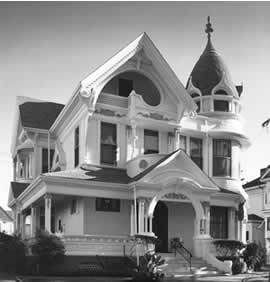
Pico Union lies just two miles southwest of Downtown LA. Similar to most of the Los Angeles area, it is a community that is both economically and ethnically diverse. (This is so much of an understatement, it's insane). But the community is also special in that it is one of twenty-two Historic Preservation Overlay Zones (HPOZ), or Historic District more broadly, which is an area composed of a group of buildings that are related to one another historically, architecturally, and/or culturally.
Some of the historic styles in the area include: 19th century Victorian-era cottages, early 20th century Craftsman and Mission Revival bungalows, and larger homes in Period Revival or Classical styles.

Pico Union, An Ever-evolving Community of Diversity:
Part of my recent work in the area was to outreach to residents about past, present, and future historic preservation efforts, the value of conservation, and the benefits of living in a historic district. Various stakeholders would like to broaden the community's interest in historic preservation, and have come together to offer a number of educational workshops in the month of January.
Our first educational workshop, which was held at the Pico Union Branch Library, was a success! There were a number of attendees consisting of students, community leaders, homeowners, renters, artists, and architects; and all are committed to preserving Pico Union's overall cultural and historical heritage.

Most of the attendees had grown up in the area and have watched it evolve overtime (an excess of bars and liquor stores were eliminated in the 80's and 90's even though other forms of blight persist until this day). Others were fascinated with the history and architecture of the area and are interested in preserving the beauty of historic homes, especially since many have been inappropriately altered or demolished altogether. And all of the attendees seemed to have tremendous pride in Pico Union, and were so invested in the cultural and historical heritage of this community that attending the event is second-nature to them.
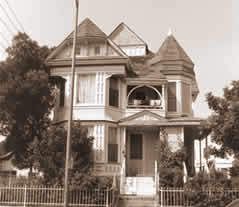
Upcoming events and workshops on Pico Union Historic Preservation Efforts include:
January 19, 2008: Pico Union Walking Tour
January 24, 2008: Benefits of Historic Preservation & the HPOZ
January 31, 2008: Dialogue with HPOZ Leaders
Please contact Mike Buhler with the LA Conservancy for more information on these events and for other historic preservation information!
Never to be Forgotten:
Finally, Pico Union has an amazing history of migration and settlement and it's emergence as a Central American enclave in Los Angeles is renowned. There are also a lot of awesome organizations in the area doing great work (I'll certainly cover this in a future post), and their existence provides yet another reason why Pico Union (and LA more broadly) is so unique:
IDEPSCA: works with day laborers and household workers in LA.
Homies Unidos: gang violence prevention and intervention.
Centro Latino: education and literacy for local residents.
SALEF: educational scholarships for Central Americans.
Eco-Academy: a charter school run by the Conservation Corps.
Maya Vision: support services for indigenous people of Mexico and Central America.
Pico Union Housing Corporation (PUHC): develop and preserve affordable housing and much more.
Memorial behind a strip mall on the corner of Pico and Union:
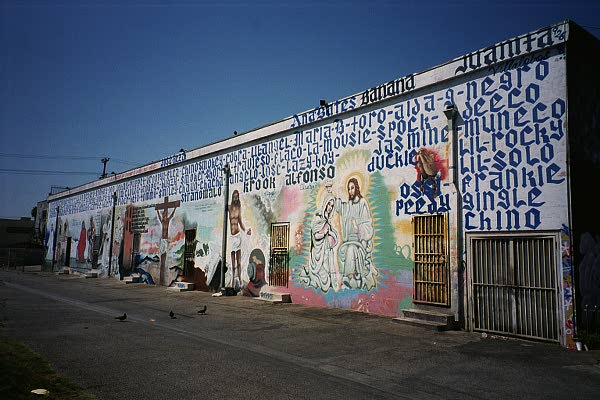
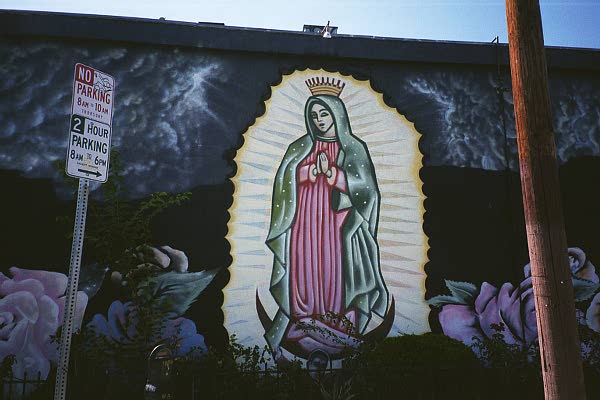
Three Blocks North of Pico and Union on Olympic and Union, La Curacao Department Store, "A Little Bit of Your Country":

All the photos of historic homes in this post are courtesy of this very informative blog on Pico Union.
I just completed an event in the Pico Union area of Los Angeles, which contains some of "the largest collections of historic homes west of the Mississippi River". These homes and this area are even more intriguing when one is exposed to the area's history and how culturally diverse and rich it has become over the years.

Pico Union lies just two miles southwest of Downtown LA. Similar to most of the Los Angeles area, it is a community that is both economically and ethnically diverse. (This is so much of an understatement, it's insane). But the community is also special in that it is one of twenty-two Historic Preservation Overlay Zones (HPOZ), or Historic District more broadly, which is an area composed of a group of buildings that are related to one another historically, architecturally, and/or culturally.
Some of the historic styles in the area include: 19th century Victorian-era cottages, early 20th century Craftsman and Mission Revival bungalows, and larger homes in Period Revival or Classical styles.

Pico Union, An Ever-evolving Community of Diversity:
Part of my recent work in the area was to outreach to residents about past, present, and future historic preservation efforts, the value of conservation, and the benefits of living in a historic district. Various stakeholders would like to broaden the community's interest in historic preservation, and have come together to offer a number of educational workshops in the month of January.
Our first educational workshop, which was held at the Pico Union Branch Library, was a success! There were a number of attendees consisting of students, community leaders, homeowners, renters, artists, and architects; and all are committed to preserving Pico Union's overall cultural and historical heritage.

Most of the attendees had grown up in the area and have watched it evolve overtime (an excess of bars and liquor stores were eliminated in the 80's and 90's even though other forms of blight persist until this day). Others were fascinated with the history and architecture of the area and are interested in preserving the beauty of historic homes, especially since many have been inappropriately altered or demolished altogether. And all of the attendees seemed to have tremendous pride in Pico Union, and were so invested in the cultural and historical heritage of this community that attending the event is second-nature to them.

Upcoming events and workshops on Pico Union Historic Preservation Efforts include:
January 19, 2008: Pico Union Walking Tour
January 24, 2008: Benefits of Historic Preservation & the HPOZ
January 31, 2008: Dialogue with HPOZ Leaders
Please contact Mike Buhler with the LA Conservancy for more information on these events and for other historic preservation information!
Never to be Forgotten:
Finally, Pico Union has an amazing history of migration and settlement and it's emergence as a Central American enclave in Los Angeles is renowned. There are also a lot of awesome organizations in the area doing great work (I'll certainly cover this in a future post), and their existence provides yet another reason why Pico Union (and LA more broadly) is so unique:
IDEPSCA: works with day laborers and household workers in LA.
Homies Unidos: gang violence prevention and intervention.
Centro Latino: education and literacy for local residents.
SALEF: educational scholarships for Central Americans.
Eco-Academy: a charter school run by the Conservation Corps.
Maya Vision: support services for indigenous people of Mexico and Central America.
Pico Union Housing Corporation (PUHC): develop and preserve affordable housing and much more.
Memorial behind a strip mall on the corner of Pico and Union:


Three Blocks North of Pico and Union on Olympic and Union, La Curacao Department Store, "A Little Bit of Your Country":

All the photos of historic homes in this post are courtesy of this very informative blog on Pico Union.
More Historic Homes in Pico Union
This Victorian home was originally located in Downtown Los Angeles on Olive near what is now Pershing Square but was later moved to Pico Union in 1909 when the Downtown area was becoming less desirable to live due to commercial and office growth.

I was running late to my own event the other day and drove by this home and laughed out loud. Here I've been doing historic preservation outreach and had still not seen many of the amazing homes in the area -- this one caught my eye immediately.

Thomas Marley was the developer of this area of Pico Union and most of the homes were developed in 1896 during the Victorian era, which typically contain lots of detailed wordwork and the use of different types of wood, among other things.

I was running late to my own event the other day and drove by this home and laughed out loud. Here I've been doing historic preservation outreach and had still not seen many of the amazing homes in the area -- this one caught my eye immediately.

Thomas Marley was the developer of this area of Pico Union and most of the homes were developed in 1896 during the Victorian era, which typically contain lots of detailed wordwork and the use of different types of wood, among other things.
Friday, January 11, 2008
"Guilty Until Proven Innocent": CRS at UCLA Panel
Went to a panel discussion put on by the UCLA School of Law's Critical Race Studies Program (CRS ) and the Muslim Public Affairs Council (MPAC). The panel was titled, "Guilty Until Proven Innocent: A Panel Discussion of Civil Rights Abuses Against Muslim Americans and Middle Easterners," and featured three very different speakers. Each speaker spoke to how the strength of US Democracy is being threatened by the US Government because certain agencies use tactics that undermine our constitutional rights, our civil liberties, and our human rights.
Georgetown Law Professor, Dr. David Cole, discussed what he calls the US Preventive Method, highlighted in his book, Less Safe, Less Free, which are some of the methods the US Government uses to counteract terrorism. Some examples include: Preventive Detention, which is the act of detaining a suspect simply because that person might do something wrong in the future, and Preventive War, which is a unilateral attack on another country because--for example--it might have particular weapons and it might provide said weapons to terrorists. Preventive war rejects International Law because it initiates an attack on another country without there first being an imminent threat of attack. Preventive detention rejects our human and civil rights because a person is detained without evidence and are considered suspects before they commit a crime.
Cole spoke briefly of a gentleman named Maher Arar who fell victim to preventive detention and coercive interrogation. Arar, who is a Canadian citizen, was to catch a connector flight from JFK to Canada. Seems the US Government felt he was connected to Al Qaeda and--after hours of interrogation and lying to his family-appointed lawyer--shipped Arar on a government chartered jet to Jordan and then to Syria, where he was detained for a year in solitary confinement in a cell that was the size of a grave. After countless interrogations, beatings, and electric shock, Syria could not corroborate the US claim that the man was in fact tied to Al Qaeda and sent him back to Canada. The Canadian government later compensated Arar with $11.5 million for their role in his detainment.
Dr. Layla Al-Marayati, Chairperson of KinderUSA highlighted personal and anecdotal experiences of how the US Government has had Muslim-serving organizations' budgets frozen, often destroying the organizations, their local and international social activism work, and various persons' reputation because they are black-listed in the process.
The last of the speakers, Dr. Maher Hathout, spoke on something dear to me because he provided a rationale to why people in Dr. Al-Marayati's anecdotes would continue to work tirelessly in social activism despite US Government efforts to prevent their work. The principles he used were familiar to me because they're also found in the Christian bible: charity, tending to the needs of orphans, widows, and aliens, and testifying against the various injustices that people face. He highlighted that Muslim-serving organizations will not falter in their work because they believe in these exact principles.
I had to leave the event early but if you would like to see a video recording of it, click here.
Georgetown Law Professor, Dr. David Cole, discussed what he calls the US Preventive Method, highlighted in his book, Less Safe, Less Free, which are some of the methods the US Government uses to counteract terrorism. Some examples include: Preventive Detention, which is the act of detaining a suspect simply because that person might do something wrong in the future, and Preventive War, which is a unilateral attack on another country because--for example--it might have particular weapons and it might provide said weapons to terrorists. Preventive war rejects International Law because it initiates an attack on another country without there first being an imminent threat of attack. Preventive detention rejects our human and civil rights because a person is detained without evidence and are considered suspects before they commit a crime.
Cole spoke briefly of a gentleman named Maher Arar who fell victim to preventive detention and coercive interrogation. Arar, who is a Canadian citizen, was to catch a connector flight from JFK to Canada. Seems the US Government felt he was connected to Al Qaeda and--after hours of interrogation and lying to his family-appointed lawyer--shipped Arar on a government chartered jet to Jordan and then to Syria, where he was detained for a year in solitary confinement in a cell that was the size of a grave. After countless interrogations, beatings, and electric shock, Syria could not corroborate the US claim that the man was in fact tied to Al Qaeda and sent him back to Canada. The Canadian government later compensated Arar with $11.5 million for their role in his detainment.
Dr. Layla Al-Marayati, Chairperson of KinderUSA highlighted personal and anecdotal experiences of how the US Government has had Muslim-serving organizations' budgets frozen, often destroying the organizations, their local and international social activism work, and various persons' reputation because they are black-listed in the process.
The last of the speakers, Dr. Maher Hathout, spoke on something dear to me because he provided a rationale to why people in Dr. Al-Marayati's anecdotes would continue to work tirelessly in social activism despite US Government efforts to prevent their work. The principles he used were familiar to me because they're also found in the Christian bible: charity, tending to the needs of orphans, widows, and aliens, and testifying against the various injustices that people face. He highlighted that Muslim-serving organizations will not falter in their work because they believe in these exact principles.
I had to leave the event early but if you would like to see a video recording of it, click here.
Labels:
Events in LA,
Faith,
Hope,
Love,
Politics,
UCLA Events
Monday, January 7, 2008
Tuesday, January 1, 2008
EXODUS: A new Year
Subscribe to:
Posts (Atom)
